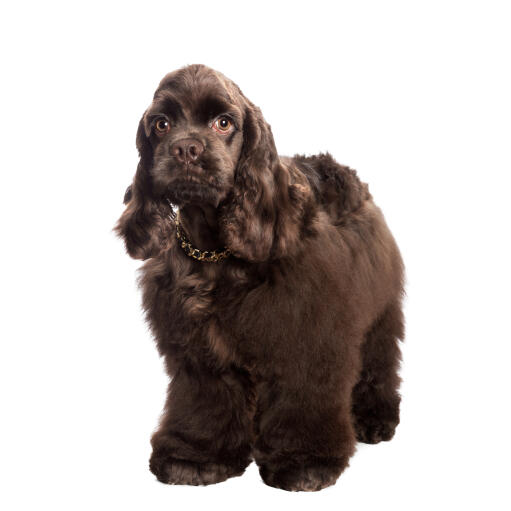Cocker Spaniel (American)





Geschichte
The Cocker Spaniel first arrived in the USA in the 1620 according to historical data; they arrived on the Mayflower. After several years of breeding, the American Cocker Spaniel club was formed and they were responsible to creating the modern day breed we know today. The breed was 'designed' to flush out and retrieve game and looks very different to the modern day English Cocker Spaniel. Their temperament also made them good pets.
Verhalten
The ACS is a lovely, lively and happy dog, who likes to be around people and gets along well with other dogs, people and children. They can be very shy, so should be socialised well from a young age and exposed to different people, places and situations to get a well rounded dog. They can be submissive and sometimes urinate when they are over excited, so careful steps should be taken when coming home. Say hello to them, but don't make a huge fuss. They don't do too well being left alone for long periods and this can lead to behavioural issues, so crate training can help with this. Getting them used to being left alone for short periods gradually will also help.
The American Cocker is happy and excitable and does well with training. They are quite intelligent, but most of their behaviour stems from a willingness to please their owner. Training should be consistent, with praise being the main reward. Like most Spaniels, they are greedy dogs, so food works well. They are very responsive to their owner's wishes. A wagging tail is normal for a Cocker and they love to make you happy and receive cuddles. Competitions such as retrieval, agility and obedience are well suited to the breed. They make excellent therapy dogs too.
With boundless energy, the Cocker needs plenty of exercise and will not be happy staying in all day with the odd walk around the block. A good hours run at least once a day will keep them happy, preferably two as they are playful when exploring their surroundings. Recall is usually good, as pets have lost their hunting nature. Games outside, such as fetch and mock hunting will keep them mentally and physically stimulated. They will want to sleep on the sofa and curl up next to you, as they really are very affectionate.
Their fur can get quite long and many people show their Cockers. The show ring requires a long coat which can take time to manage. Most opt for a shorter cut, more like the English Cocker Spaniel which is more manageable. Daily brushing will remove dead hair, burrs and tangles and they will need clipping every few months. The eyes will need wiping to prevent tear staining.
With the breeding of American Cockers comes associated health issues. Patellar Luxation, cataracts and cherry eye are more common along with Progressive Retinal Atrophy. A condition known as IMHA is also seen.
Charakter
American Cocker Spaniels have a happy and gentle temperament. Closer to a toy breed than their English cousin the American Cocker Spaniel still possesses enough athleticism to enjoy a decent daily walk. They are a loving, sociable breed who will become very attached to their families and be happy to meet anyone. They can be a noisy breed and some suffer from timidity which can be reduced through early socialisation.
Gesundheitliche Probleme
Heal problems that may affect American Cocker Spaniels include eye diseases, skin problems, orthopedic diseases (canine hip dysplasia etc.), hypothyroidism, epilepsy, heart disease, blood clotting disease and liver disease.
The American Cocker Spaniel is one of the breeds most prone to a large array of health problems (due to high levels of inbreeding). It is very important to check the breeding stock of an American Cocker Spaniel before you consider buying one if you don't want to end up paying literally thousands of pounds in vet bills.
Einzelheiten zur Rasse
- Status: Common
- Lebenserwartung: 12 - 15 years
- Produktgewicht: 11 - 14 kg
- Höhe: 14 - 15.5"
- Selten: Nein
- Fell: Lang
- Pflegeanforderungen: Täglich
- Stadt oder Land: Beides
- Mindestanforderungen an Umgebung: Kleines Haus
- Mindestanforderungen an Garten: Großer Garten
- Rassetyp: Jagdhund
- Version: Größe M
- Energieniveau: Größe M
- Benötigte Bewegung: Mehr als zwei Stunden









